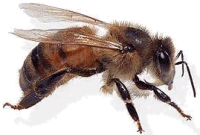WORKING WITH BEESWAX
Recovering Beeswax
A hive of bees can produce more than 1lb.of wax each season. Wax taken from a beehive contains many debris which must be removed before it can be put to good use.
The easiest way to remove impurities from wax is with a solar extractor, basically an insulated container with a double glazed lid.
The old cappings, foundation, scrapings, etc. are placed on a metal rack over a dark-coloured tray. If the extractor is left outside with the lid closed, on a sunny day the temperature inside the extractor soon rises above 145 degrees F which is sufficient to melt the wax.
The melted wax trickles through a fine mesh and drips into a container. When it solidifies it should be stored in sealed plastic bags until needed.
Solar extractors can be bought from equipment suppliers or can be made fairly easily at home.
Beeswax products
Beeswax furniture polish is the purest form of polish you can find. It gives a mirror-like finish combined with a wonderful smell. To make the polish you need:
- 4 ozs. Beeswax
- 1 pint. Rainwater
- 8 fl.oz. Turpentine
- 1 level tablesoon Bicarbonate of soda
- a small piece of Soap.
Shred the beeswax and soap and combine with the remaining ingredients over a very gentle heat, stirring continuously . When the mixture has a smooth, creamy consistency it can be poured into suitable containers and left to cool.
Beeswax also makes fine candles. It smells delightful and burns slowly. There are three basic types of beeswax candle:
- Foundation candles these are the easiest to make as there is no need to collect and melt down beeswax. Foundation candles are made by rolling a sheet of unwired wax foundation firmly around a length of wick, keeping the roll tight. The candle is finished off by gently warming the loose edge and pressing it down securely.
- Dipped candles this method requires a large quantity of molten beeswax and a great deal of patience! A length of wick is dipped into the wax and allowed to cool. This process is repeated over and over again until the required thickness is achieved. This is a tricky procedure as the wax has a tendency to drip or slide off.
- Moulded candles this type of candle is made by filling moulds
with melted beeswax. Moulds are made in a variety of different shapes,
sizes and materials and are available from equipment suppliers.
The mould should be lubricated with glycerine, liquid detergent or silicone spray as beeswax tends to stick to its mould. After warming the mould the wax is poured around the wick and allowed to cool slowly in an upright position. When cooled completely the candle can be released carefully from its mould.
